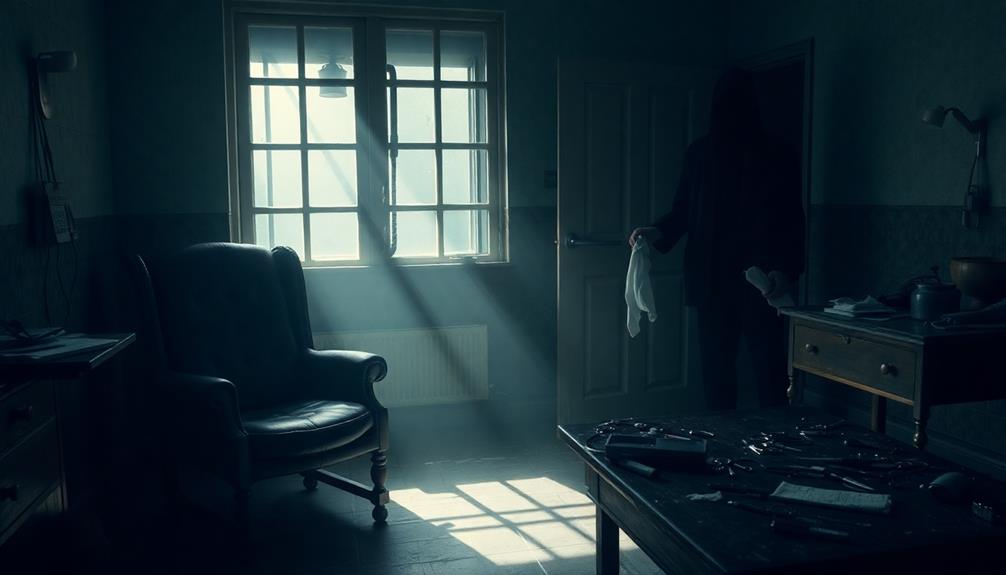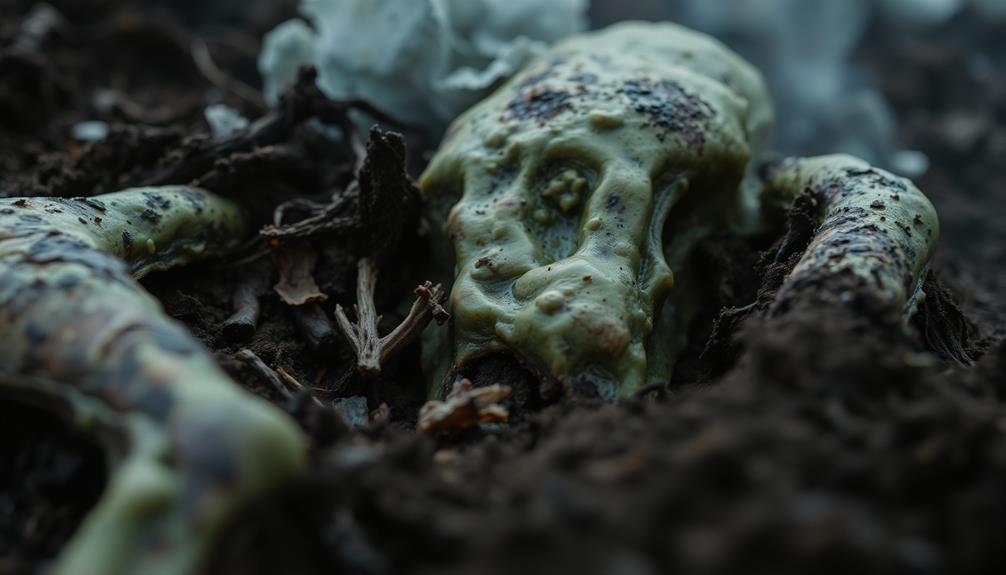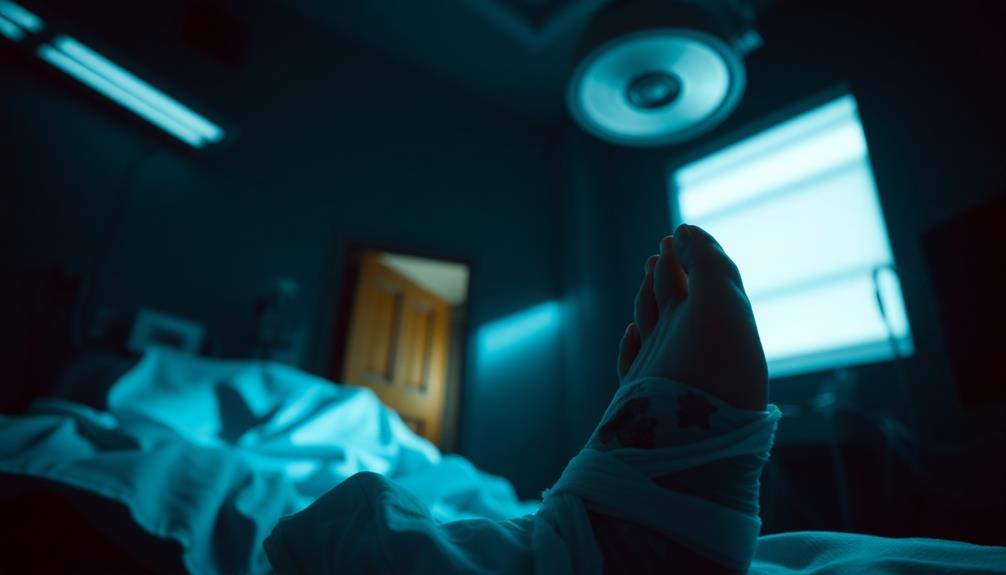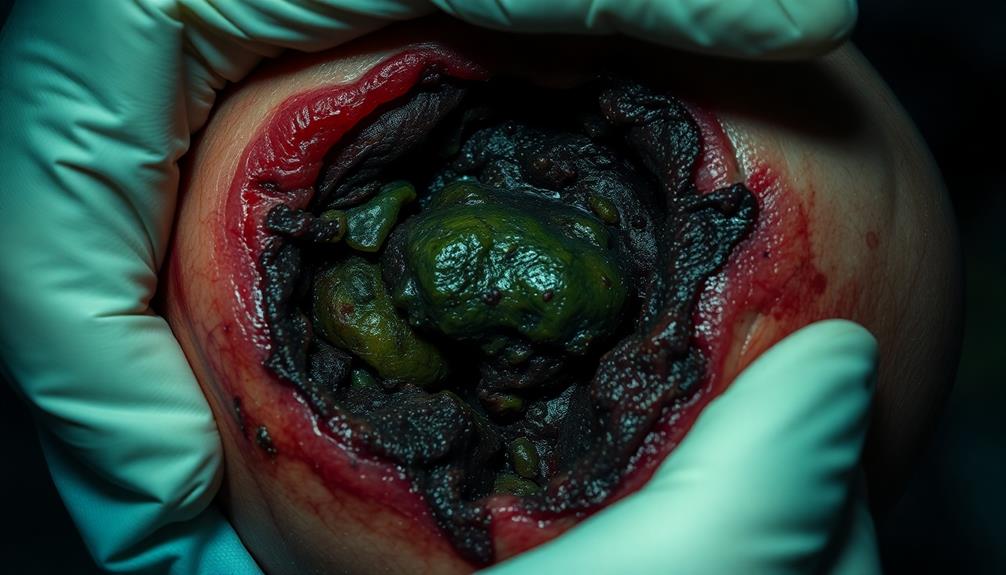Gangrene has a smell that's really hard to ignore. It's often described as a mix of rotting flesh and decay, which signals that there's a serious health issue at hand. You might notice a putrid, foul odor, especially with wet gangrene, where dead tissue and bacteria mix. Gas gangrene even has a sickly sweet scent from the gases released by certain bacteria. This unpleasant aroma serves as a warning that you should seek help right away. Recognizing it can be crucial for getting the care you need quickly, and there's even more to discover about its signs and symptoms!
Key Takeaways
- Gangrene emits a noxious odor reminiscent of rotting flesh and decay, signaling serious infection and tissue breakdown.
- Wet gangrene produces particularly foul smells due to rapid tissue decay and the presence of pus.
- Gas gangrene has a distinct "sickly sweet" scent caused by gases released from Clostridium bacteria.
- The intensity of the odor correlates with the amount of dead tissue and bacteria, indicating advanced gangrene.
- Recognizing the smell is crucial for early detection and prompt medical intervention to prevent severe complications.
Introduction

When you think of gangrene, one of the first things that might come to mind is its unmistakable odor. This foul-smelling scent often arises from a bacterial infection and decaying tissue. Imagine the combination of rotting flesh with a sweet, putrid smell; it's not something you'd easily forget!
In cases of gas gangrene, the odor gets even more intense due to gas produced by Clostridium bacteria during tissue breakdown. Understanding the importance of recognizing such symptoms could be crucial, especially in cases related to tick-borne diseases that may lead to similar infections.
Healthcare professionals often use this strong, necrotic odor as a diagnostic indicator when assessing wounds for signs of gangrene. If you notice this smell, it's crucial to seek medical help quickly. Early detection can lead to faster medical intervention, which is vital for better treatment outcomes.
Understanding the characteristics of gangrene's smell can empower you to recognize potential issues in yourself or others. It's not just about the unpleasant smell; it's a key factor in identifying a serious condition.
Description of the Smell

The smell of gangrene is unmistakable and can be described as a noxious blend of rotting flesh and decay. When you encounter it, you might notice a strong, putrid odor that no one could easily ignore. This foul-smelling discharge is often linked to dead tissue and bacterial infection, which is what makes the scent so offensive.
In cases of wet gangrene, the smell can be particularly rank, as the rapid decay of tissue releases even more unpleasant odors. Changes in the body, such as those seen in chronic diseases like diabetes, can increase the risk of developing gangrene, which underscores the importance of monitoring health conditions and recognizing warning signs early detection and prevention strategies.
Interestingly, if the gangrene is caused by certain bacteria, like Clostridium species, you might even pick up a sweet or fruity smell. This happens because these bacteria produce gases during tissue breakdown.
However, regardless of the specific scent, a strong, offensive odor typically signals advanced gangrene, which requires immediate medical intervention.
Recognizing this smell is crucial, as it can alert you or someone nearby to seek help. Remember, the quicker you act, the better the chances for recovery. So, if you ever detect that foul, unmistakable odor, don't wait—reach out to a medical professional right away!
Source and Composition

Understanding the source and composition of gangrene's smell involves recognizing the role of necrotic tissue and the bacteria that thrive in decaying environments. When tissue dies, or becomes necrotic, it breaks down, creating a foul-smelling odor. This smell can be described as putrid or similar to rotting flesh, mainly due to bacterial infections, especially in cases of wet gangrene.
The presence of certain bacteria can significantly increase the risk of complications, underscoring the importance of monitoring credit card statements regularly to catch potential fraud early.
The bacteria, such as Clostridium species, play a significant role in this process. They feast on the dead tissue, releasing gases that contribute to the strong odors. In gas gangrene, you might notice a distinct "sickly sweet" scent because of gases like hydrogen sulfide and organic acids produced by these bacteria.
The intensity of the smell can change based on how much tissue has died and the number of bacteria present. Recognizing this characteristic smell can be crucial for healthcare professionals, as it aids in early diagnosis and intervention.
Typical Scenarios or Environments

In various medical settings, especially those involving trauma or surgery, the presence of gangrene can create a challenging environment for healthcare professionals. You might notice a foul odor that fills the air, one often described as a putrid smell or even "decaying meat." This odor arises from dead tissue and bacterial infection, making it a significant concern for doctors and nurses.
In cases of wet gangrene, the smell can be even stronger, mixing with pus and other fluids. Meanwhile, gas gangrene gives off a unique sweet odor, thanks to the gases released by Clostridium bacteria during tissue breakdown. These different smells can be a crucial diagnostic indicator.
Imagine being in a surgical room where the scent of infection is strong; it's not just unpleasant but also a signal that something needs immediate attention.
The environments where gangrene is present—like emergency rooms or trauma centers—are particularly pungent. By understanding these typical scenarios, healthcare professionals can better assess and treat patients, ensuring they receive the care they need, even when faced with such challenging conditions.
Emotional or Cultural Associations

Experiencing the smell of gangrene can evoke strong emotional reactions, often rooted in societal fears and cultural narratives surrounding death and disease. The foul, putrid odor, similar to rotting flesh, brings feelings of revulsion and anxiety. You might find yourself thinking of decay, mortality, and the fragility of life itself.
Cultural depictions of gangrene often emphasize its horrific fragrance, linking it to severe illness and death. In literature and art, this smell symbolizes decay, encouraging reflections on life's impermanence.
Historical accounts, especially from wartime, highlight the dreadful scent tied to infected wounds, deepening the stigma around injuries.
These emotional responses shape public perceptions of health and hygiene practices. When you encounter this smell, it's hard not to think about the importance of cleanliness and the fear associated with infections.
This connection between the smell of gangrene and our emotional reactions shows how deeply intertwined our senses are with cultural beliefs. By understanding these associations, you gain insight into how we perceive health and mortality, and why the fragrance of decay can leave a lasting impact on our minds and hearts.
Health or Safety Considerations

The pungent odor of gangrene serves as a crucial warning sign that something is seriously wrong with your health. If you notice a foul odor coming from a wound, it could mean there's decaying tissue and a serious infection at play. This smell is often described as rotten or similar to spoiled meat, which can be hard to ignore.
In cases of gas gangrene, you might even hear a characteristic crackling sound under the skin, adding to your concerns.
When you encounter an unpleasant smell from wounds, it's essential to take action. This odor signals an urgent need for medical evaluation. Delaying treatment can lead to potential complications, which is something no one wants to face.
Remember, gangrene can escalate quickly, turning a manageable issue into a life-threatening situation.
If you or someone you know experiences this kind of smell, don't hesitate to seek help. Getting prompt medical evaluation can make all the difference in ensuring a positive outcome. Your health is important, and recognizing these warning signs is a step toward taking control and getting the care needed.
Final Thoughts

Recognizing the signs of gangrene, especially its distinctive smell, is vital for your health and safety. The odor associated with gangrene is often foul, like rotting flesh mixed with a sweet, sickly scent. This smell comes from the decay of necrotic tissue and the bacteria at work, breaking down proteins and releasing gases.
In cases of wet gangrene, you might notice this odor even more strongly. If you ever detect this unpleasant smell, it's a critical sign that medical intervention is needed.
The presence of gas pockets, especially in gas gangrene, can lead to a crackling sensation under your skin. This means bacteria are causing serious damage, and recognizing these signs early can prevent further tissue damage and complications.
Frequently Asked Questions
Is There a Smell of Gangrene?
Yes, there's definitely a smell of gangrene. You might notice a foul, putrid odor that can be quite strong. It often indicates tissue decay and infection, so it's crucial to seek medical attention immediately.
How Do You Know if Gangrene Is Starting?
You'll know gangrene is starting if you notice unusual swelling, discoloration of the skin, or blisters. If you detect a foul smell from a wound, don't wait—seek medical attention immediately to prevent complications.
How Long Can You Live With Untreated Gangrene?
If you leave gangrene untreated, your survival time can drastically decrease. Depending on the type, you might face severe complications, including limb loss or death, often within days to weeks without immediate medical attention.
Which Ointment Is Best for Gangrene?
When treating gangrene, you should consider silver sulfadiazine or honey-based dressings for their antimicrobial properties. Always consult your healthcare provider to determine the best ointment based on your specific situation and severity.









